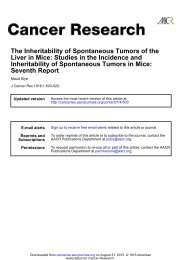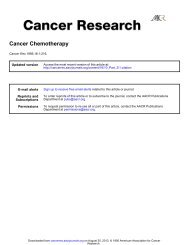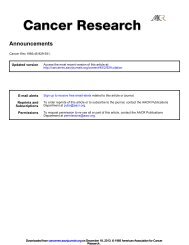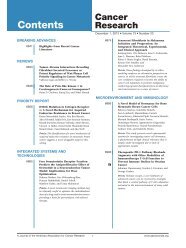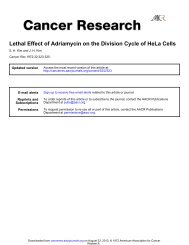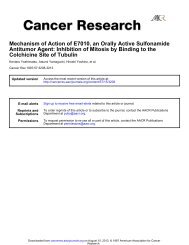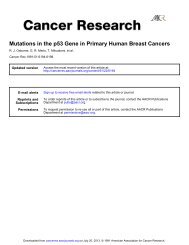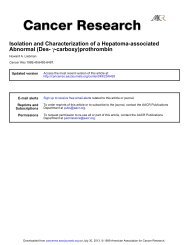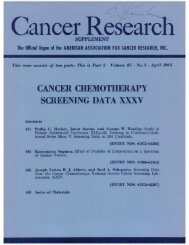Trichothiodystrophy, a Human DNA Repair ... - Cancer Research
Trichothiodystrophy, a Human DNA Repair ... - Cancer Research
Trichothiodystrophy, a Human DNA Repair ... - Cancer Research
You also want an ePaper? Increase the reach of your titles
YUMPU automatically turns print PDFs into web optimized ePapers that Google loves.
O 25<br />
UVDOSEtJ/ri2]<br />
100<br />
10 0 2.5<br />
UVDOSElJrn2]<br />
Fig. 3. <strong>Repair</strong> synthesis in TTD cells. A, scintillation counting. Nondividing<br />
cells were UV irradiated and labeled with 10 /iCi/ml [3H]thymidine for 2 h in the<br />
presence of 10 mM hydroxyurea. The radioactivity incorporated into unirradiated<br />
cells (usually about 1 cpm/100 cells) was subtracted from that in irradiated cells.<br />
Results show means ±SEM (bars) of 3-6 experiments for all cell lines except P2<br />
(single experiment). B, autoradiography. C equilibrium centrifugaron. Following<br />
UV irradiation confluent cultures of "P-labeled cells were labeled for 3 h with 10<br />
^Ci/ml ['H]thymidine in the presence of 10~5M bromodeoxyuridine and 10~*M<br />
fluorodeoxyuridine. and the <strong>DNA</strong> was extracted and centrifuged to equilibrium<br />
in alkaline CsCl gradients. Ordinate, specific activity of the 'H label associated<br />
with normal density <strong>DNA</strong>. The results from one of three experiments is shown.<br />
In D the same experiment was carried out but with exponentially growing cells.<br />
Normals 123 CS XP 0 20<br />
UV DOSEUm'<br />
Fig. 4. RNA synthesis after UV irradiation. A, nondividing cells were UV<br />
irradiated (15 J/m2) and 16 h later they were pulse labeled with ['H|uridine for 1<br />
h. Results are expressed as a percentage of incorporation compared to that in<br />
unirradiated cells. Bars, SEM. B. dose response for RNA synthesis.<br />
that of normal cells, its response being similar to that of cells<br />
from patients with XP or Cockayne's syndrome and of a strain<br />
<strong>DNA</strong> REPAIR DEFECT IN TR1CHOTH1ODYSTROPHY<br />
TTD4PV from an Italian patient previously described by Ste<br />
fanini et al. (7) (Fig. 1). Likewise the mutability of P2 cells to<br />
6-thioguanine resistance was greatly enhanced like that of XP<br />
cells (Fig. 2A). Furthermore more SCEs were induced in P2<br />
(Fig. 28), as has previously been shown for excision-defective<br />
XP cells (23). These cellular abnormalities could be attributed<br />
to a deficiency in excision-repair, as shown by a reduced rate of<br />
removal of UV-induced damage, measured as endonucleasesensitive<br />
sites (Fig. 5), and a low rate of UDS as shown in Fig.<br />
3/4. The reduced survival and UDS in P2 are properties similar<br />
6092<br />
OC<br />
to those of cell strains from four photosensitive Italian TTD<br />
patients (7).<br />
The deficiency in UDS forms the basis of a genetic comple<br />
mentation test for XP, and it has been used to reveal nine<br />
different complementation groups. In these studies cells from<br />
different XPs were fused and UDS was measured in the result<br />
ing heterokaryons. Restoration of UDS to levels found in<br />
normal cells indicates that the two donor cells are in different<br />
complementation groups. Conversely, if UDS remains at the<br />
reduced levels of the donor cells the two donors are assigned to<br />
the same complementation group. Previous work (7) showed<br />
that four TTD strains failed to complement XPs from comple<br />
mentation group D. Results shown in Table 2 show that P2 did<br />
not complement two of these previously studied TTD strains,<br />
TTD3PV and TTD4PV. UDS in the heterokaryons remained<br />
at the same level as in the parental cells. In contrast, when<br />
these strains were fused with an XP strain from complementa<br />
tion group C (XP9PV), UDS in the heterokaryons was restored<br />
to normal levels. In contrast, in heterokaryons from PI and<br />
TTD3PV or TTD4PV, UDS was restored to normal levels.<br />
Thus PI cells, unlike P2 cells, are able to correct the defect in<br />
TTD3PV and TTD4PV.<br />
The genetic disorder Cockayne's syndrome is, like XP, UV<br />
sensitive at the cellular level but, in contrast to XP, shows no<br />
obvious deficiency in excision-repair (24). Nevertheless in CS<br />
cells RNA synthesis fails to recover following its depression by<br />
UV irradiation, whereas in normal cells rapid recovery occurs<br />
to normal levels (17). Observation of this deficiency in CS cells<br />
can be optimized by using nondividing cells and measuring<br />
RNA synthesis 16-24 h after irradiation with a high UV fluence<br />
(25). Fig. 4A shows that under these conditions, as reported<br />
previously, RNA synthesis in XP and CS cells was reduced to<br />
very low levels whereas in normal cells it had recovered almost<br />
to unirradiated levels. In contrast to the normal response of PI,<br />
RNA synthesis was reduced to 10% of unirradiated levels in<br />
P2.<br />
Patient 3. The cellular responses of P3 (filled squares in<br />
figures) to the lethal (Fig. 1), mutagenic (Fig. 2A), and SCEinducing<br />
(Fig. IB) effects of UV irradiation were, as with PI,<br />
indistinguishable from those of normal cells. Likewise the rate<br />
of removal of UV endonuclease-sensitive sites in normal and<br />
P3 cells were the same (Fig. 5). In marked contrast, however,<br />
measurements of UDS revealed a clear deficiency in P3, partie-<br />
Table2 Complementation ofTTDcells<br />
Cultures of two parental cell strains, a and b. labeled with latex beads of<br />
different sizes, were fused, incubated for 48 h at 37"C, UV irradiated (20 J/m1),<br />
and incubated for 3 h with [3H]thymidine. Autoradiography was performed and<br />
the number of grains over the nuclei in 50 mononuclear parental cells and in 25<br />
heterokaryons was counted (12).<br />
Fusion partners<br />
(axb)Experiment<br />
1P2<br />
TTD3PVP2 x<br />
TTD4PVP2 x<br />
XP9PVPI X<br />
TTD3PVPI x<br />
TTD4PVPI X<br />
XP9PVExperiment<br />
X<br />
2P3<br />
TTD3PVP3 x<br />
TTD4PVExperiment<br />
x<br />
3P3<br />
XP9PVP3 x<br />
x XP25ROa12.4<br />
1.49.8 ±<br />
0.812.4± ±<br />
1.178.5<br />
2.971.2 ±<br />
±2.475.6<br />
2.029.7 ±<br />
0.430.9 +<br />
0.930.9 ±<br />
Grains/nucleus ±SEM<br />
Parental cells<br />
1.412.8 ±<br />
0.81 +<br />
0.79.4 3.4 ±<br />
0.814.8 ±<br />
±0.615.1<br />
1.07.4 ±<br />
0.311.4 ±<br />
±0.412.7<br />
±0.912.5+<br />
1.159.7<br />
1.271.2 ±<br />
±2.664.9<br />
1.274.4 ±<br />
2.029.2 ±<br />
0.930.5 ±<br />
0.471.1 ±<br />
1.534.0 ± 0.55.1 + 3.469.3 ±<br />
±2.6b13.4 ±0.5Heterokaryons12.9 ±4.9<br />
Downloaded from<br />
cancerres.aacrjournals.org on August 13, 2013. © 1988 American Association for <strong>Cancer</strong><br />
<strong>Research</strong>.




